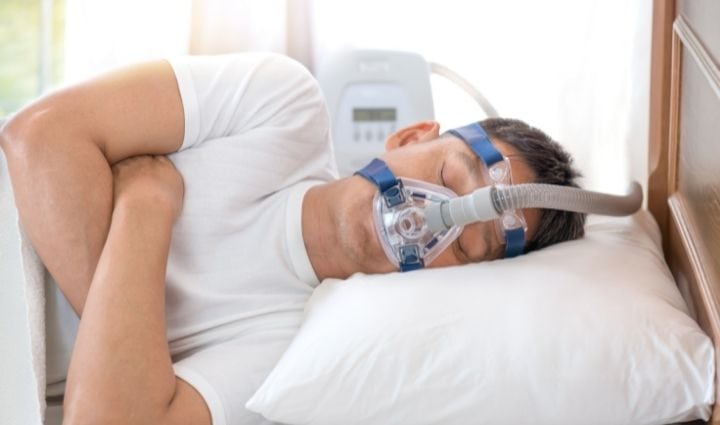CPAP therapy is the first in line treatment for obstructive sleep apnea (OSA) because it’s non-invasive, safe, and effective. But as with all treatments, there are some side effects that CPAP machine users may experience.
While side effects are typically mild, they can annoy users enough to make them choose to stop using their CPAP machine. These side effects are easy to treat, so before you hang up your face mask and call it quits, keep reading to learn some of the most common side effects of CPAP machine use and their solutions.
#1. Nasal Congestion
Irritation of the nasal passages is the most common side effect associated with CPAP therapy. When using a CPAP machine, you may have a runny or stuffy nose, feel a burning sensation, or experience nosebleeds. This happens due to the dry, pressurized air flowing through your sinuses.
Solution
One way to avoid nasal congestion is to use a saline nasal spray to keep your nasal passages moist. A long-term solution would be to use a CPAP humidifier. The humidifier will add moisture to the airflow and help alleviate dryness and soothe irritation. There are also heated humidifiers available that will warm the air while it moisturizes.
#2. Dry Mouth
If you are a mouth breather, you may experience a dry throat or mouth. Similar to nasal congestion, this dryness is caused by dry, pressurized air.
It’s common in people who use nasal masks because of mouth leak, but it can also happen to those who use full face masks. Mouth leak happens when you sleep with your mouth open, and the air pressure escapes from your mouth when you exhale.
Solution
A CPAP humidifier will help with this issue no matter what type of mask you use. If you use a nasal or nasal pillow mask, using a CPAP chinstrap can help by keeping your mouth closed while you sleep.
#3. Dry Eyes
A leak in your mask can lead to dry eyes as the air blows across your face. The amount of leakage may change as you change positions during the night, so you may not even notice the leak.
Solution
Make sure your mask fits properly. Lying in your preferred sleeping position, try adjusting your mask. You should also make sure that your headgear fits properly. Obviously, loose straps can cause air leaks, but a tight fit can also cause leaks by keeping the cushion from sealing correctly.
#4. Aerophagia
Higher pressure settings can cause you to swallow air leading to aerophagia. Aerophagia occurs when the continuous positive airway pressure becomes hard to breathe against, and you swallow air. Symptoms include burping, bloating, passing gas, and stomach pain.
Solution
The pressure setting to your machine may be to blame if you are experiencing aerophagia. Contact your sleep specialist or doctor before adjusting your pressure settings. Never attempt to change the settings without their supervision.
#5. Trouble Exhaling
You may experience difficulty exhaling against the continuous airflow when using your CPAP machine. As a result, you may feel shortness of breath, even when there is enough air.
Solution
Take a look at your CPAP machine’s exhalation relief settings. Adjusting this setting will reduce the pressure of airflow when you exhale. Before making any adjustments, contact your sleep specialist or doctor.
You could also speak to your doctor about switching to an APAP machine that monitors your breathing and adjusts the pressure settings based on your needs. Your doctor may also recommend a BiPAP machine which provides a higher pressure when you inhale and a lower pressure when you exhale.
#6. Acne and Skin Irritation
Your mask can collect oil, dead cells, and sweat from your skin while you sleep. This can lead to bacteria and germs on your mask, causing rashes, irritation, sores, and acne.
Solution
Keeping your CPAP equipment clean will help avoid this problem. You should wash your mask regularly and replace your cushions every 2-4 weeks. Even when you clean your equipment regularly, micro-tears in the foam or silicone can allow germs to collect over time.
#7. Claustrophobia
When you first start using a CPAP machine, you may need some time to get used to the mask and tubing. This is especially true if you are using a full-face mask. This feeling typically goes away with time, but it can make it challenging to get into the habit of using your CPAP machine regularly.
Solution
Practicing wearing your mask during the day for a short time can help you get used to the feeling of the mask and hoses. After a while, wear your mask with the machine running while you’re watching TV in bed or reading. Switching to a nasal or nasal pillow mask can help as well since they have a smaller profile and you have a wider field of vision.
DreamZz Can Help You Choose the Best CPAP Machine For You
Side effects from CPAP machines aren’t typically dangerous, but they can lead people to give up on sleep therapy. That’s why having comfortable CPAP accessories is vital, they can be the difference between getting an amazing night’s sleep and giving up.
The Dream Team at DreamZz Sleep Center can help you find the CPAP machine and accessories that suit your situation the best. Along with CPAP machines, we offer masks, headgear, hoses, filters, and water chambers from reputable brands such as Fisher & Paykel, Philips Respironics, and Resmed, so you can rest easy knowing you’re using the best possible equipment.
Contact us today to learn more.


Recent Comments